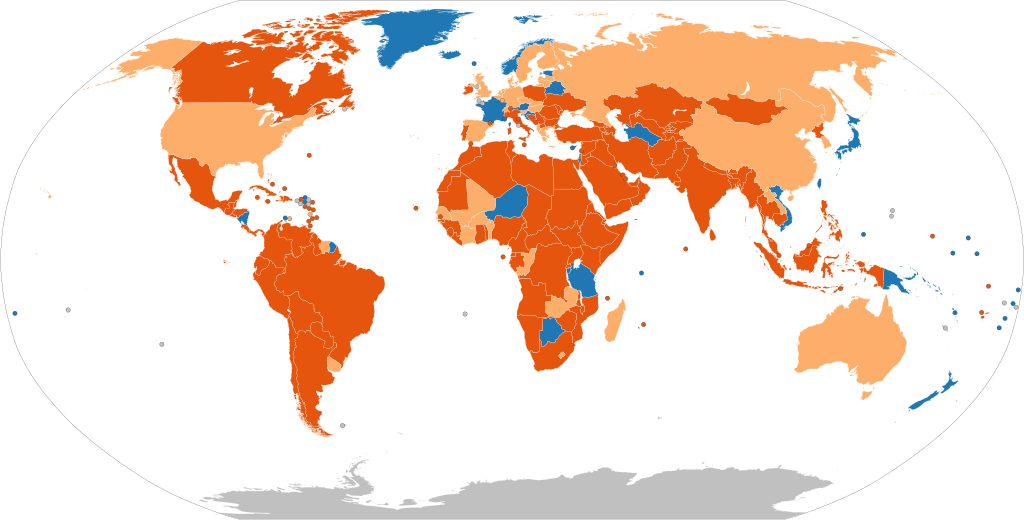
United Kingdom
The UK has been one of the worst hit countries and schools have been up until recently only open for a small number of children, including those of whom have parents that are critical workers, we've looked at the UK in more detail in our previous blog, available here.
France
The French government surprised their citizens when lockdown restrictions were eased on May 11th, as the government decided to go against the advice of the conseil scientifique (the scientific group responsible for informing decisions about the pandemic surrounding COVID-19), who recommended not continuing classes until September. Schools across the country were issued with a 56-page document detailing instructions on how to keep the premises clean and students safe.
France has since been faced with a large social divide, with a sizeable amount of people choosing not to send their children to school at risk of spreading the virus further. France’s education minister, Jean-Michel Blanquer, confirmed the divide was largely between wealthier and poor families. He confirmed that this was also part of the reason why schools in France had started to reopen in May rather than in June. Stating, "we know that it’s a step-by-step process with poor families. It takes time to persuade people".
Shortly after schools in France were reopened, 50 schools were forced to close due to a rise in COVID-19 cases within the schools.
Higher education in France is still continuing remotely as of the time of writing this article.
Spain
Around 8.2 million students across Spain have been learning remotely since the state of alarm went into effect on March 14th. Since then, Spain had released their 4-phase plan to de-escalate from COVID-19 lockdown. The guidelines set out that children under the age of 6 whose parents could prove that they were not able to work from home could go back to school in phase 2 of the de-escalation plan. This plan was however rejected by Prime Minister, Pedro Sánchez, following a meeting with representatives of the education ministry during which the regional chiefs expressed their concerns regarding the possibilities of maintaining social distancing rules with such young children.
The Spanish Paediatric Association have since recommended that all schools stay closed until the new school year begins in September. This does not include students in their final year of secondary school and post-secondary schools, who were allowed to continue classes in groups of no more than 15 students in order to prepare for their university entrance exams.
The Spanish government has allowed individual regions to determine if they wish to reopen schools for students of any other age or if they would prefer to continue with online teaching and remote learning. Although, all plans are different across the country, one of the more common themes appears to be that no regions have made the return to schools mandatory for any students and are mainly offering help or private tuitions for students who wish to use them.
Germany
Just a few weeks after the lockdown was officially announced in the first few states in Germany on March 20th, students of certain groups had already been allowed to return to school in order to prepare for their final exams. After Chancellor, Angela Merkel, announced the gradual reopening of schools, parents across the country began to voice their concerns. This was followed with the decision for each German state to decide on their own plan on how to reopen schools.
While parents in the German state of Saxony won the rights to optional attendance for students, a small school in Neustrelitz - a small town in Northern Germany - had a lot of eyes on them as they were one of the first schools in the world to offer testing up to twice a week for all staff and students. The school acknowledged they were only able to do so as they were offered free coronavirus test kits. Although, there appears to be many concerns about these tests, such as students having to test themselves and the swabs being less reliable because of it; this method has been said to have reduced the amount of anxiety surrounding the return to school.
The German government has encouraged individual provinces and schools to decide what procedures work best for them. Schools across other States of Germany have been advised to only carry out face-to-face classes for groups no larger than 15 students while maintaining safe, social distancing.
New Zealand
At the time of writing this article, New Zealand confirmed only one active case of coronavirus and have aimed to lift all lockdown restrictions as there have been no new cases reported for nearly 2 weeks. The country had started reopening schools when the COVID-19 alert level was lowered to level 2. The level 2 alert plan specified that all early learning centres and tertiary education facilities were to reopen to all age groups, provided that there were no confirmed or probable causes of COVID-19.
When researching, I spoke to a primary school teacher who informed me that there were plenty of online resources available. However, according to results from a survey carried out at the school, parents found there was too much online learning for their children to do during the lockdown period. Students have since returned to school and although there were many articles written about how excited they were to return to school, teachers noticed students seemed to show high levels of anxiety about germs and being near to others.
Schools are implementing a number of social distancing measures within and around the schools, such as "kiss and go" zones where parents are able to drop off their children, as well as dividing students up into three groups for play time to avoid the overcrowding of the school playgrounds. Teachers are required to disinfect tables, handles and equipment and students are prompted to wash their hands as often as possible.
Denmark
Although schools in Denmark were only shut for four weeks, the country had to introduce measures to support the reopening of schools. It had been reported that a large number of parents had doubts about the speedy reopening and there was a lot of anxiety within the community; however, there are systems in place to avoid the spread of the coronavirus.
Students are placed in small groups with as little contact with other students and teachers as possible. These small groups, also referred to as 'micro groups' arrive in school at different times, eat their lunch separately and are only allowed in certain sections of the school and playground. Teachers are appointed to their own micro group of students and are to remain with only their own group each day.
A further measure that has been introduced is mandatory hand washing every hour, which has unfortunately caused an issue of skin irritation and eczema. Students and teachers have however not been required to wear face masks in or around school. Some outdoor classes have also been taking place - weather permitting.
Norway
In Norway, national lockdown was announced on March 12th. The education system was quick to respond by getting students connected to Microsoft Teams where teachers could help by answering individual questions or working with groups of students in a class setting. Work was handed out and divided into three categories:
- Have to do work: homework which all students are required to do
- Should do work: homework which students should do however is not mandatory
- Can do work: extra work for students to do
Students returned to school on May 11th, starting with day care and early year students as well as students in their final years of both high school and university. Primary school students were encouraged to enter the school one by one to ensure social distancing guidelines were met. When the remainder of school years were informed, they could go back to school, businesses and individuals around the country teamed up to help each other - in larger cities gym halls were made available for day cares to use and in smaller villages people offered their land as an educational ground to schools.
China
Following the lockdown announcements in Wuhan city in china on January 23rd, Chinese government bodies and professors have been working on an online learning system for all students as they had been forced to work remotely. The re-opening measures across china have been very different in every region. The Shanghai government announced late in April that students who were in their final year of middle school or high school were able to return to school. Schools in Eastern China have also issued their students special hats which measure the distance required for social distancing.
When China announced their students were going back to school, they reported that they would "treat (students) like it's kindergarten" as days would be shorter, classes smaller and students would not be allowed to take public transport into school. Schools across China are also measuring all of their student's temperatures before entering classes to avoid the spread of the virus.
Japan
As the state of emergency is being lifted across multiple prefectures, schools across Japan have started reopening with small groups of students attending at different times. Some schools in the country have been going through a "warm up" period to get students familiar with everyday school-life again in order to make the transition to full days more tolerable. Japan has reportedly decided to send their sixth graders, as well as their third-year junior high students back to school for full days in preparation for them to study abroad as well as for international students to study in Japan. Students and teachers across the country are still required to wear face masks while attending school as well as adhering to the regular social distancing guidelines.
The rest of the world
We've only covered a very small number of countries in this article, but there are some facinating resources with more details of how Covid-19 has impacted schools beyond those we've looked at in the references section below.
Conclusion
While doing my research for this piece, I was surprised to see that the measures across the world in response to COVID-19 have been so similar in some ways, yet so different. All countries are relying on internet access to continue their education. Unfortunately, there are so many countries around the world where access to internet or technology is not possible at all. These roadblocks to students are going to impact their futures but the gravity of this is something that at the moment we can't quantify. I think it's imperative that where possible, we all try and bridge the gap and help remove these hurdles.
 September 2025
- 4 minute read
September 2025
- 4 minute read
 May 2025
- 4 minute read
May 2025
- 4 minute read
 February 2025
- 4 minute read
February 2025
- 4 minute read
 November 2024
- 4 minute read
November 2024
- 4 minute read
 September 2024
- 4 minute read
September 2024
- 4 minute read
 April 2024
- 4 minute read
April 2024
- 4 minute read








